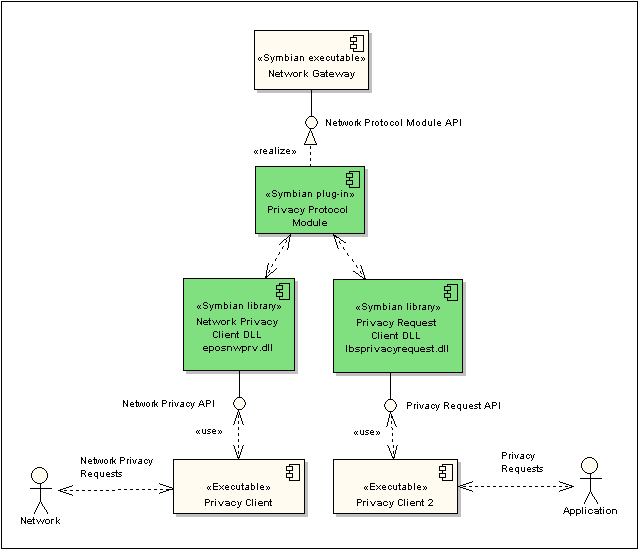Privacy Protocol Module Overview
The Privacy Protocol Module (PPM) is an optional LBS component that allows the LBS subsystem to process privacy requests from the device domestic OS. The privacy request may have been received from the network or from an installed application.
Purpose
The Network Gateway (NG) is the LBS subsystem component that interfaces the LBS subsystem with a network. The NG loads a Protocol Module to support a specific protocol and location based services architecture.
A Protocol Module such as the SUPL Protocol Module interfaces directly to the network to process privacy requests and location requests. The Privacy Protocol Module allows the LBS subsystem to process privacy requests from the device domestic OS.
Required background
A knowledge of LBS Privacy Requests is assumed.
Key concepts and terms
See Privacy Requests for key concepts.
Architecture
Figure 1 shows the Privacy Protocol Module in context in the LBS subsystem.
The PPM is an optional LBS component. To use the PPM, LBS must be configured so that the PPM is part of the LBS subsystem and so that the Network Gateway loads it on startup.
The PPM is a Protocol Module ECOM plug-in that implements the Network Protocol Module API. The Network Protocol Module API defines functions for processing both privacy requests and location requests. The PPM implements only the privacy request processing functions and cannot be used to process location requests.
The PPM contains a server that handles privacy requests sent from one of two PPM client libraries. A client process uses one of the client libraries to send privacy requests to the PPM and to receive privacy responses (acceptance or denial of the request). The PPM starts the LBS subsystem if it is not running when a privacy request is received.
Privacy requests are sent into the LBS subsystem via the Network Gateway. They are processed by a Privacy Controller or Privacy Notifier (not shown on figure 1) which returns a privacy response.
Note that the PPM does not connect directly to the network to receive privacy requests. In figure 1, the Privacy Client executables are processes that run in the domestic OS. They receive privacy requests and use one of the PPM client libraries to send them into the LBS subsystem.
APIs
There are two APIs that can be used to send privacy requests to the PPM.
Typical uses
The PPM can be used when a device creator wants to use the LBS subsystem to process privacy requests.
The privacy request is typically sent to the PPM by a process running in the device domestic OS. The process may have received the request either from the network or from an installed application.
Copyright ©2010 Nokia Corporation and/or its subsidiary(-ies).
All rights
reserved. Unless otherwise stated, these materials are provided under the terms of the Eclipse Public License
v1.0.
